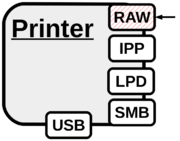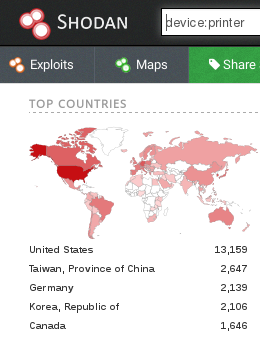Port 9100 printing
Raw printing is what we define as the process of making a connection to port 9100/tcp of a network printer – a functionality which was originally introduced by HP in the early 90s using separate hardware modules. It is the default method used by CUPS and the Windows printing architecture [1] to communicate with network printers as it is considered as ‘the simplest, fastest, and generally the most reliable network protocol used for printers’ [2]. Raw port 9100 printing, also referred to as JetDirect, AppSocket or PDL-datastream actually is not a printing protocol by itself. Instead all data sent is directly processed by the printing device, just like a parallel connection over TCP. In contrast to LPD, IPP and SMB interpreted printer control or page description languages can send direct feedback to the client, including status and error messages. Such a bidirectional channel is not only perfect for debugging, but gives us direct access to results of PJL, PostScript or PCL commands, for example for [information disclosure] attacks. Therefore raw port 9100 printing – which is supported by almost any network printer – is used as the channel for security analysis with PRET and PFT.
Who would put a printer on the Internet?
Obviously, a port 9100 based attack requires IP packets to be routed from the attacker to the printer device and backwards but printers usually are not directly connected to the Internet [3]. As of February 2017, the Shodan search engine reveals 48,213 printing devices Internet-accessible trough port 9100.
Attacking intranet printers however may also be attractive to an insider. Imagine an employee who has motivation to obtain the department manager's payroll print job from a shared device. It is also worth mentioning that many new printers bring their own wireless access point – unencrypted by default to allow easy printing, for example via AirPrint [4] compatible mobile apps, or they automatically connect to an access point provided by the attacker with a "default" SSID [5]. While connecting to a printer through Wi-Fi requires the attacker to stay physically close to the device, it may be feasible to perform her attack from outside of the targeted institution depending on the signal strength.
→ Related articles: Fundamentals, Attack carriers, PRET, PFT
- Jump up ↑ Windows Printer Driver Architecture, Microsoft Corporation
- Jump up ↑ Network Protocols supported by CUPS – AppSocket Protocol, M. Sweet
- Jump up ↑ It however must be noted that in many educational institutions it is common even today to assign a public IP address to all networked devices including printers.
- Jump up ↑ About AirPrint, Apple Inc.
- Jump up ↑ Rogue Device Spotlight: Wireless Printers, Robert Awk, Pwnie Express Blog

